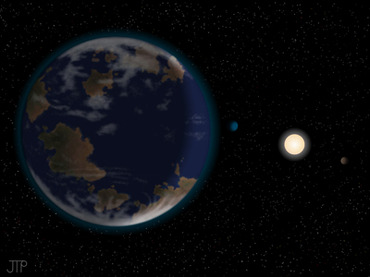
Dwarf star HD 40307g hosts a system of six planets, and one of those is believed have the potential to support human life.
The newfound exoplanet was discovered by a team of astronomers from the University of Hertfordshire and the University of Goettingen.
It’s located a mere 44 light-years from Earth. And although that may seem like a far distance, it’s actually just around the corner – cosmically speaking. It’s so close that researchers say telescopes on Earth may be able to image it directly.
The alien planet has been classified as a super-Earth, meaning it’s larger than Earth but smaller than gas planets such as Neptune.
It orbits at a distance of 55.8 million miles from the sun, which puts it in its host star’s habitable zone – the region where liquid water can exist on a planet’s surface.
But it’s not just the possibility of water that has astronomers thinking the newfound planet could be habitable.
The dwarf star is likely rotating on its own axis instead of having one face permanently turned toward the sun. The result is an Earth-like day and night cycle.
“The longer orbit of the new planet means that its climate and atmosphere may be just right to support life. Just as Goldilocks liked her porridge to be neither too hot nor too cold but just right, this planet – or indeed any moons that it has – lie in an orbit comparable to Earth, increasing the probability of it being habitable,” study co-author Hugh Jones said in a statement.
Exploring the exoplanet
Astronomers previously detected three other super-Earths around the same host star – all of which were in orbits too close to their sun to house water.
But in a new study, a research team reanalyzed observations of the HD 40307 system by using the High Accuracy Radial velocity Planet Searcher, HARPS.
The tool allows astronomers to pick up tiny gravitational wobbles that an orbiting planet induces in its parent star.
And while the study brought forth a new discovery, astronomers say they’re far from knowing all the answers surrounding the exoplanet.
The super-Earth may or may not be a rocky planet like earth, according to lead author Mikko Tuomi.
“If I had to guess, I would say 50-50… but the truth at the moment is that we simply do not know whether the planet is a large Earth or a small, warm Neptune without a solid surface,” Tuomi told SPACE.com.
The next step for the team will be to use space-based telescopes to get a more direct look at the exoplanet and examine its composition.
